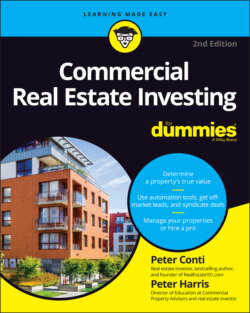Читать книгу Commercial Real Estate Investing For Dummies - Peter Harris - Страница 48
THE TECHNICAL MEANING BEHIND THE NUMBERS
ОглавлениеCap rate, cash flow, cash-on-cash return, and net operating income are investment terms that we explore in this chapter, but what do they really mean to you as an investor? Here’s the in-depth explanation:
Capitalization rate: A cap rate is used as a measure of a property’s performance without considering the mortgage financing. If you paid all cash for the investment, how much money would it make? What’s the return on your cash outlay? Cap rate is a standard used industrywide, and it’s used many different ways. For example, a high cap rate usually typifies a higher risk investment and a low sales price. High cap rate investments typically are found in low-income regions. A low cap rate usually typifies a Iower risk investment and a high sales price. Low cap rates typically are found in middle-class to upper income regions. Therefore, neighborhoods within cities have their assigned cap rates “stamped” on them.That said, if you know what the NOI is, and you know the given cap rate, you can estimate what the sales price should be: sales price = NOI ÷ cap rate. For example, if the NOI is $57,230 and you want to make investments into 7 percent cap properties, the price you’ll offer will be $817,571 (57,230 ÷ 7 %). This is a good way to come up with your first offer price — at the very least, it’s a starting point.
Cash flow: Positive cash flow is king, and it’s one of your primary objectives in investing. Positive cash flow creates and maintains your investments’ momentum. When purchasing an apartment building containing more than five units (considered commercial), a bank’s basis for lending is the property’s cash-flow capabilities. Your credit score is a lower priority than the cash-flow potential. An apartment building with poor cash flow almost always will appraise much lower than its comparables for the area. Finally, positive cash flow keeps you sleeping at night when property values drop, because your bills and mortgage will still be paid.
Cash-on-cash return: This is the velocity of your money. In other words, how long does it take for your down payment to come back to you? If your down payment were $20,000, how soon would your monthly cash flow add up to $20,000? If your cash flow added up to $20,000 in one year, your cash-on-cash return would be 100 percent. If it takes two years, your cash-on-cash would be 50 percent. If it takes three years, it would be 33 percent.Commercial real estate investing can produce phenomenal returns. Cash-on-cash returns of more than 100 percent aren’t uncommon. Now, if you were to go to your local bank and deposit $20,000 into its most aggressive CD investment for one to three years, what type of cash-on-cash return could you expect? Maybe 1 percent or if you’re really lucky 4 percent? You need to put an emphasis on cash-on-cash return when you invest simply because you need to know how fast you and your investors can get the down payment back so everyone can invest it again — and again into future deals that you find.
Net operating income (NOI): This term is one of the most important ones when analyzing any deal. The net operating income is the dollar amount that’s left over after you collect all your income and pay out your operating expenses. This amount is what’s used to pay the mortgage. And what’s left after you pay the mortgage is what goes into your pocket — your cash flow.Always keep your eye on the NOI and look for ways to increase it by either raising rents or reducing expenses. As the NOI increases, so will the value of your property. In fact, if you’re in an 8 percent cap neighborhood, for every $100 that the NOI increases, your property value will increase by $1,250. Is that a good return for your efforts or what?You know that cap rate = NOI ÷ sales price, but you also can flip the calculation: sales price (or value) = NOI ÷ cap rate. Therefore, you can figure a new value by dividing your new NOI or increase of NOI by the going cap rate. So, $100 ÷ 8 percent = $1,250. Now, if you can increase your NOI by $20,000, your property value will have gone up by $250,000 ($20,000 ÷ 8 percent = $250,000).
